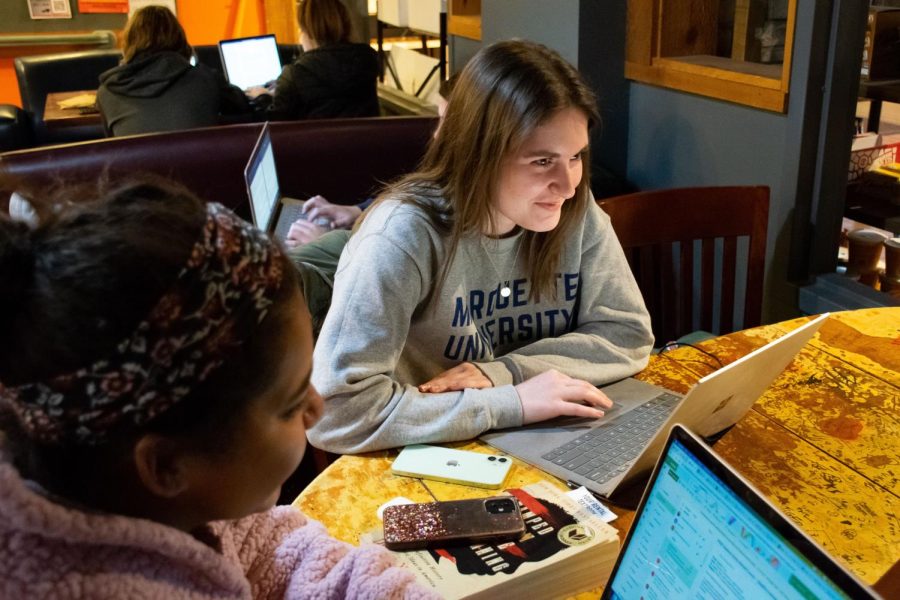“Considering what has been going on the past couple of months, you just feel concerned walking out as a Black person. You have no idea what is going to happen to you…It doesn’t matter what your status is, anyone is at risk as a Black person.” says Chima Korieh, professor of Africana Studies at Marquette, about the importance of America addressing race issues that continue to exist today.
Cedric Burrows, an assistant English professor at Marquette, says the Black Lives Matter movement is closely tied to the ongoing coronavirus pandemic.
He says the movement is pushing for access to testing, research on specifically how COVID-19 affects Black people’s jobs and health, and continuing demands for adequate healthcare for the Black community. Racial injustices that existed before the coronavirus are being brought to light as the pandemic has exacerbated medical racism within the healthcare system.
Barriers to receiving proper healthcare treatment directly affects the disproportionate rates with which African Americans contract COVID-19. According to Milwaukee County’s website, as of August 7 Milwaukee city and county had 20,734 positive cases of the coronavirus. 5,763 Black residents tested positive and 5,729 white residents tested positive. Milwaukee’s African American population is about 41% according to the United States Census.
Historically, African Americans have suffered at the hands of the healthcare system. Such injustices include: Dr. J. Marion Sim’s experiments where he conducted research on Black slave women without anesthesia in the 1840s and the Tuskegee experiments in the 1930s where hundreds of black men were injected with syphilis and not given effective care so that researchers could track the disease’s full progression, among other examples.
“People from some racial and ethnic minority groups are disproportionately represented in essential work settings such as healthcare facilities, farms, factories, grocery stores, and public transportation,” the Centers for Disease Control and Prevention website says. These are jobs where individuals cannot work from home, forcing them to decide between a paycheck and their safety.
In addition to essential work, the CDC website also cites more crowded living conditions in minority communities, discrimination in the healthcare system, access to healthcare and wealth and education gaps as factors that put members of minority and Black communities at higher risks of contracting COVID-19.
These socioeconomic injustices can correspond to healthcare inequality through a lack of insurance, absent education on symptoms, poor representation in the field, minimal access to testing and inadequate care as a result of not being able to pay for treatment.
In Wisconsin, 8% of Black people are uninsured or had inadequate health insurance all of last year, according to the Wisconsin Department of Health Services. This is double the percentage of uninsured individuals in the total state population. If an uninsured Black person were to contract the virus, not only could they be at higher risk because of already existing health conditions, but they might not have the resources to pay for treatment that is necessary. This forces Black patients to make a difficult choice: wait to receive care when their condition is severe or risk getting inadequate care due to an inability to pay.
Rhiannon Torres, a senior in the College of Nursing, says that affordability can make a huge difference in how professionals with existing biases interact with their patients. Torres, during her time as a nursing student, has had clinicals at St. Joe’s hospital in Milwaukee in the maternity ward. Nurses and doctors might be less inclined to give full care to someone who cannot pay and that comes from a different or difficult background, she says.
“You kind of get the sense that some nurses or medical professionals have a negative association with some of the clients at St. Joe’s. You get people of all different types of backgrounds … especially when those are minority mothers or people of color, you kind of see that negative association among the nurses at some point,” Torres says. “It’s never a good look to be talking negatively (about) your patients. It just shows how you feel towards them and it can definitely affect the level of care.”
Victoria Houle, a junior in the College of Nursing, says she understands that it is difficult to tell a community that is suffering to advocate for themselves and question the authority around them, but that it is important that people do not remain silent when they experience medical racism.
“Use your voice. Don’t be silenced by a system that might be corrupt at times. Don’t be afraid to speak about how it makes you feel or how it has impacted you, your friends, or your community,” Houle says. “Voices have power.”
One medical student-run organization that is supported by the Black Lives Matter Movement that has recently gained momentum is White Coats for Black Lives. This group’s main goals are to increase representation of people of color in healthcare professions and provide equal care to all patients despite background, race or ability to pay. The push for equal representation in the health profession is particularly important in building trust and comfort between patient and doctor.
Burrows says that in his research on the Black Lives Matter movement, he found it is crucial to consider whose lives have historically mattered in society and whose lives have been considered disposable. When looking at different historical events where the Black community suffered at the hands of healthcare workers, Black people were dehumanized and experimented on for the progression of the health of others, and this made clear whose lives were valued at the time, Burrows suggests. Burrows continued to highlight how this heightened value for certain members of the community may still inadvertently exist today.
“In the beginning [of COVID-19] there was talk of how the disproportion of the people dying were Black people and then we started seeing how things were to open up again,” Burrows says.
He felt that the media may have affected certain communities feeling safer to go out and return to normal. If the media just states that African American communities are being heavily affected, other communities might think that they will be okay; that it isn’t their group that is at high risk so they shouldn’t worry.
Korieh is living in Milwaukee during the pandemic. He says he was disappointed when the city lifted its quarantine order, because it appealed to communities that felt safe returning to normal at the expense of vulnerable communities.
“People went to court to try to get the state to open up when the crisis had not gone away, it was appalling,” Korieh says. “We are seeing the cases rise in Milwaukee as a result of the premature opening, which has of course increased the crisis in the most challenged population which is the Black community.”
Torres also comments that people use their privilege to ignore precautions that protect not only themselves, but also the most vulnerable and at-risk communities during the pandemic.
“I think the overall culture of people in the U.S. has been pretty backwards,” Torres says. “It’s a very individualistic culture we live in.”
Many states, including Wisconsin, decided to reopen over the past three months. In some states, the choice to lessen restrictions resulted in a spike of cases, forcing some states to close again and enforce heavier restrictions to combat the increase. The New York Times has a map of updated restrictions by state.
In Wisconsin, the state Supreme Court struck down Gov. Tony Ever’s stay-at-home order on May 13th. The court sided with Republican lawmakers who argued that Gov. Tony Evers’ administration should not have the power to act unilaterally when making decisions about public health during the pandemic, which they felt the stay-at-home-order did. This sudden lack of universal, state-wide restriction, despite the continued existence of the coronavirus and a lack of a vaccine increased risks of infection, especially among communities that lack resources, such as proper health insurance. With no COVID-19 policies in place, bars, restaurants, and other businesses were allowed to open unless local officials implemented their own restrictions.
As of July 14, the City of Milwaukee issued a mask ordinance which requires people to wear masks when in public. With this ordinance, four locations around the city provide free masks to the public, including the Milwaukee Department of Health and Southside Health Center. There are also several free testing sites around the city, including free testing provided by the Wisconsin National Guard, regardless of symptoms, in south and north city. These steps are incredibly important to ensure all people have access to resources to prevent the spread of the coronavirus.
Houle has been working with isolated COVID-19 patients this summer at St. Joe’s where she gives patients their medication, documents full body assessments, checks lung function and brings them their food. She says it is important to recognize the coronavirus for what it is: a medical issue.
“Medical professionals know what they are doing, they know what they are looking for, so we really need to include them in decisions regarding this pandemic,” Houle says. “Why are we leaving it up to politicians who aren’t even sure of what the disease process is or how impactful it is?”
Korieh similarly says he thinks the pandemic has become too political.
“I think that the issue in the United States is that, more than any other country in the world, COVID had been looked at through the lens of politics and it is important to understand that this disease, or any other disease, does not think about ideology and it affects everybody whether you belong to the left or the right,” Korieh states. “It is important that the U.S. speaks with one voice and that we listen to the doctors and we make decisions based on facts and science.”
This story was written by Maria Crenshaw. She can be reached at [email protected].



